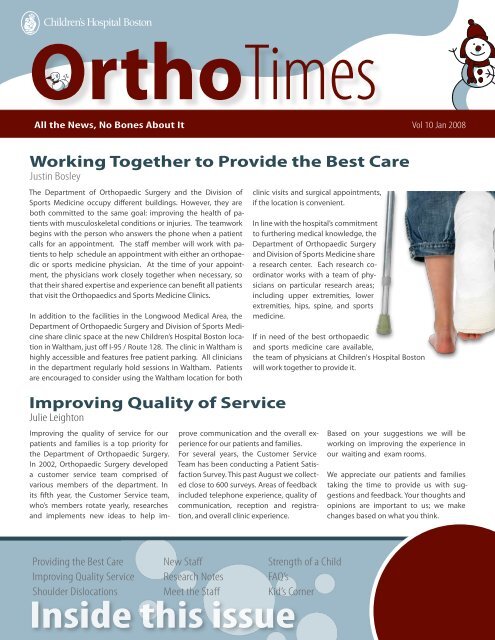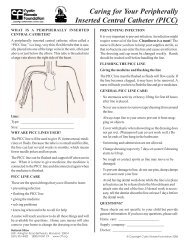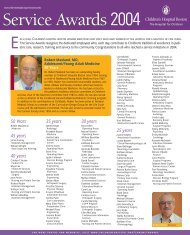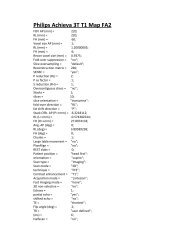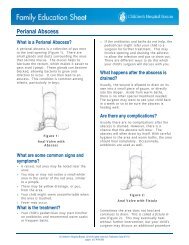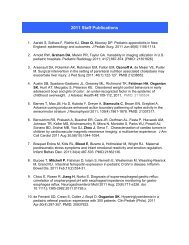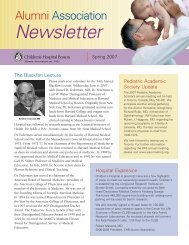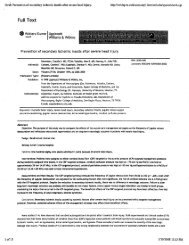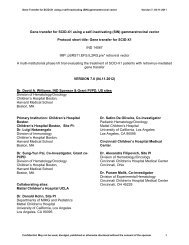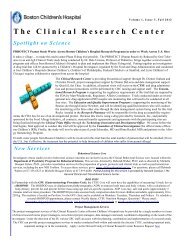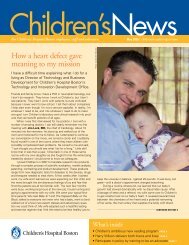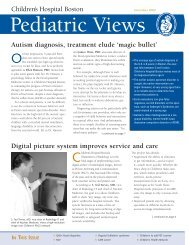New Staff - Children's Hospital Boston
New Staff - Children's Hospital Boston
New Staff - Children's Hospital Boston
You also want an ePaper? Increase the reach of your titles
YUMPU automatically turns print PDFs into web optimized ePapers that Google loves.
OrthoTimes Vol<br />
All the <strong>New</strong>s, No Bones About It<br />
Working Together to Provide the Best Care<br />
Justin Bosley<br />
The Department of Orthopaedic Surgery and the Division of<br />
Sports Medicine occupy different buildings. However, they are<br />
both committed to the same goal: improving the health of patients<br />
with musculoskeletal conditions or injuries. The teamwork<br />
begins with the person who answers the phone when a patient<br />
calls for an appointment. The staff member will work with patients<br />
to help schedule an appointment with either an orthopaedic<br />
or sports medicine physician. At the time of your appointment,<br />
the physicians work closely together when necessary, so<br />
that their shared expertise and experience can benefit all patients<br />
that visit the Orthopaedics and Sports Medicine Clinics.<br />
In addition to the facilities in the Longwood Medical Area, the<br />
Department of Orthopaedic Surgery and Division of Sports Medicine<br />
share clinic space at the new Children’s <strong>Hospital</strong> <strong>Boston</strong> location<br />
in Waltham, just off I-95 / Route 128. The clinic in Waltham is<br />
highly accessible and features free patient parking. All clinicians<br />
in the department regularly hold sessions in Waltham. Patients<br />
are encouraged to consider using the Waltham location for both<br />
Improving Quality of Service<br />
Julie Leighton<br />
Improving the quality of service for our<br />
patients and families is a top priority for<br />
the Department of Orthopaedic Surgery.<br />
In 2002, Orthopaedic Surgery developed<br />
a customer service team comprised of<br />
various members of the department. In<br />
its fifth year, the Customer Service team,<br />
who’s members rotate yearly, researches<br />
and implements new ideas to help im-<br />
Inside this issue<br />
clinic visits and surgical appointments,<br />
if the location is convenient.<br />
In line with the hospital’s commitment<br />
to furthering medical knowledge, the<br />
Department of Orthopaedic Surgery<br />
and Division of Sports Medicine share<br />
a research center. Each research coordinator<br />
works with a team of physicians<br />
on particular research areas;<br />
including upper extremities, lower<br />
extremities, hips, spine, and sports<br />
medicine.<br />
prove communication and the overall experience<br />
for our patients and families.<br />
For several years, the Customer Service<br />
Team has been conducting a Patient Satisfaction<br />
Survey. This past August we collected<br />
close to 600 surveys. Areas of feedback<br />
included telephone experience, quality of<br />
communication, reception and registration,<br />
and overall clinic experience.<br />
If in need of the best orthopaedic<br />
and sports medicine care available,<br />
the team of physicians at <strong>Children's</strong> <strong>Hospital</strong> <strong>Boston</strong><br />
will work together to provide it.<br />
Providing the Best Care <strong>New</strong> <strong>Staff</strong> Strength of a Child<br />
Improving Quality Service Research Notes FAQ’s<br />
Shoulder Dislocations Meet the <strong>Staff</strong> Kid’s Corner<br />
10 Jan 2008<br />
Based on your suggestions we will be<br />
working on improving the experience in<br />
our waiting and exam rooms.<br />
We appreciate our patients and families<br />
taking the time to provide us with suggestions<br />
and feedback. Your thoughts and<br />
opinions are important to us; we make<br />
changes based on what you think.
Shoulder Dislocations<br />
Donald S. Bae, MD<br />
Kickoff<br />
The air has turned cooler, snow is starting to fall, and the <strong>New</strong><br />
England Patriots and <strong>Boston</strong> Celtics are back to their winning<br />
ways…all sure signs that winter is here. With the change in seasons,<br />
many children and adolescents are looking forward to the<br />
return of winter sports. Sports participation continues to rise<br />
both regionally and nationally. It is estimated that over 35 million<br />
children and adolescents participate in organized sports, and the<br />
majority of households will have at least one child participating<br />
in athletic activities.<br />
As sports participation continues to<br />
rise, particularly in younger<br />
children and adolescents at<br />
higher levels of competition,<br />
so too has our awareness<br />
of sports related injuries,<br />
including shoulder<br />
dislocations.<br />
More Than Just a Ball<br />
and Socket<br />
The shoulder is a complex<br />
connection between the<br />
arm and body, designed<br />
to allow motion and<br />
stability. One of the<br />
main components<br />
of the shoulder is<br />
figure 1<br />
the glenohumeral<br />
joint, which links<br />
the upper portion<br />
of the humerus bone (humeral head) to the bony socket of the<br />
scapula (the glenoid) (figure 1). While the glenohumeral joint has<br />
often been described as a “ball and socket” joint, in truth, the connection<br />
is more complex.<br />
The glenoid is more shallow than the humeral head is round, and<br />
thus the humeral head can shift out of the center of the glenoid<br />
(subluxation) or completely move out of the glenoid (dislocation).<br />
To prevent this, the joint is dependent upon the surrounding soft<br />
tissue for stability. The glenoid is surrounded by a “bumper” or<br />
rim of cartilage, called the labrum, which adds to glenohumeral<br />
figure 2<br />
joint stability (figures<br />
2 and 3). This<br />
labrum acts similar<br />
to the chock<br />
blocks that are<br />
placed around<br />
the wheels of<br />
airplanes and figure 3<br />
used to keep<br />
the wheels from<br />
moving (figure<br />
4). In addition,<br />
the labrum is<br />
connected to<br />
the shoulder joint<br />
ligaments and capsule,<br />
which provide additional stability.<br />
In a shoulder dislocation from a fall or sports-related injury, there<br />
may also be injury to the labrum, ligaments, and joint capsule<br />
(figure 5). Though the humeral head may be placed back into the<br />
glenoid, the injured labrum, ligaments, and/or capsule may not<br />
heal in their original position, thus increasing the likelihood of repeated<br />
shoulder dislocations.<br />
Initial Care<br />
Following a shoulder dislocation, treatment initially consists of<br />
manipulating the humeral head back into the center of the glenoid.<br />
While this can happen spontaneously, occasionally manipulation<br />
needs to be done with a physician’s guidance with<br />
sedation or anesthesia. After reduction of a shoulder dislocation,<br />
patients are typically treated with sling immobilization, followed<br />
by physical therapy to restore shoulder motion and strengthen<br />
the muscles around the shoulder. Despite appropriate care of a<br />
first-time shoulder dislocation, the likelihood of recurrent shoulder<br />
instability episodes may be as high as 60 to 95 percent in adolescents<br />
and young adults.<br />
In patients involved in contact sports (e.g. football), specialized<br />
braces have been designed to restrict the shoulder from being<br />
placed in vulnerable positions and thus reduce the likelihood of<br />
repeated instability events. continued on page 3<br />
Welcome <strong>New</strong> <strong>Staff</strong><br />
Virginia Brunelle<br />
The Department of Orthopaedic Surgery is<br />
pleased to announce that Kimberly Bayliss, RN<br />
and Erin Dawicki PA-C, have joined our clinical<br />
support team.<br />
The Orthopaedic clinical support team includes,<br />
nurses, nurse practitioners, and physician assistants.<br />
Each member of the clinical support<br />
team contributes a fundamental role in providing<br />
care to our patients and families with integrity,<br />
compassion, and expertise.<br />
Kimberly Bayliss, RN<br />
Kimberly attended Northeastern University,<br />
where she received a Bachelor of Science in<br />
Shoulder Dislocations,<br />
continued from page 2<br />
These braces may be used to allow athletes<br />
to return to sports participation for<br />
the remainder of their season or indefinitely.<br />
Surgical Treatment<br />
In patients with recurrent shoulder dislocations<br />
that do not improve with physical<br />
therapy and activity modification, surgical<br />
treatment is an option. Ultimately the<br />
decision to pursue surgery is made by<br />
the patient/parents and treating orthopaedic<br />
surgeon after careful evaluation<br />
and discussion.<br />
Surgery for shoulder instability is designed<br />
to repair and/or tighten the<br />
labrum, ligaments, and joint capsule<br />
around the shoulder. In most situations,<br />
this may be performed using arthroscopy.<br />
Small incisions are made around the<br />
shoulder and an arthroscope (or pencilsized<br />
camera) is used to look inside the<br />
glenohumeral joint.<br />
-2- -3-<br />
Nursing. Prior to joining the Orthopedic Clinic,<br />
Kimberly worked at Children’s on 10 Northwest,<br />
an inpatient unit. She has also worked at<br />
<strong>New</strong> England Medical Center, in the Pediatric<br />
Intensive Care Unit, and Franciscan <strong>Hospital</strong> for<br />
Children.<br />
Erin Dawicki, PA-C<br />
Erin attended the Medical University of South<br />
Carolina where she received a Master of Science<br />
in Physician Assistant Studies. Erin most recently<br />
worked as an EMT on the Disaster Medical Assistance<br />
Team at Rhode Island <strong>Hospital</strong>.<br />
Specialized instruments are then used to<br />
repair the injured labrum, ligaments, and<br />
capsule.<br />
There are some situations in which arthroscopic<br />
techniques are not used.<br />
figure 4<br />
figure 5<br />
Instead, the shoulder surgery is<br />
performed using a longer incision<br />
over the front of the shoulder joint.<br />
This is often referred to as “open” surgery.<br />
Your Home Team<br />
The Department of Orthopaedic Surgery<br />
at Children’s <strong>Hospital</strong> <strong>Boston</strong> has a number<br />
of healthcare providers who are available<br />
to help young athletes with shoulder<br />
instability. Our team of orthopaedic surgeons,<br />
physical therapists, nurses, and orthotists<br />
is well trained and ready to assist<br />
young athletes pursue successful, enjoyable,<br />
and safe sports seasons. In this<br />
game, we want everyone to be a winner.<br />
1. Candy cane<br />
2. Hockey<br />
3. Superbowl<br />
6. Patriots<br />
Across Down<br />
Kid’s Corner Answers<br />
4. Penguin<br />
5. Gingerbread<br />
6. Plow<br />
7. Salt<br />
8. Ski<br />
9. Snowflake
Hand and Upper Extremity Research<br />
Emily Reiff<br />
Drs. Peter Waters and Donald Bae lead<br />
the research efforts for the hand and<br />
upper extremity team in orthopedics.<br />
With a particular interest and experience<br />
in brachial plexus birth palsy (BPBP),<br />
they coordinate an ongoing multicenter<br />
research study to define the<br />
optimal treatment for this condition.<br />
Collaborating with doctors in North<br />
America and Australia that treat similar<br />
patients, the physicians are gathering<br />
information at each clinic visit, surgery<br />
and radiographic exam to ultimately<br />
perform a comprehensive analysis on a<br />
large patient population to determine<br />
the optimal timing for microsurgical<br />
intervention in affected infants.<br />
Drs. Waters and Bae continue to publish<br />
extensively on BPBP injuries including;<br />
quality of life assessments, economic<br />
analysis on the timing of microsurgery,<br />
and the effects of BPBP on the growing<br />
shoulder joint. Recently Dr. Waters<br />
presented a study on muscle volume<br />
measurements in patients with BPBP<br />
injuries at the annual Grice Day<br />
research symposium.<br />
Meet the <strong>Staff</strong><br />
Dennis Burke<br />
Billy Maxwell is our newest cast<br />
technician in orthopaedics. Born and<br />
raised in Tampa Bay, Florida - Billy<br />
began his career as an athletic trainer<br />
for the Tampa Bay Buccaneers and<br />
later the Cincinnati Reds. He later<br />
joined Tampa General <strong>Hospital</strong> and<br />
Children’s <strong>Hospital</strong>, in St. Petersburg<br />
Florida, as a cast technician. Billy will be working in our <strong>Boston</strong><br />
and Waltham locations. He will also be assisting surgeons, in<br />
the operating room,with cast applications. Please welcome<br />
Billy to Orthopeadics.<br />
In addition to the research on brachial<br />
plexus, the hand and upper extremity<br />
team conducts clinical research on<br />
traumatic, congenital, and other<br />
neuromuscular conditions. The<br />
American Society for Surgery of the<br />
Hand recently awarded research funding<br />
to Drs. Water and Bae to study the<br />
outcomes of children who sustained<br />
supracondylar humerus fractures with<br />
associated blood vessel or nerve injury.<br />
Supracondylar humerus fractures are<br />
common injuries, in which the long<br />
bone of the arm is broken just above the<br />
elbow joint. By measuring vascular and<br />
neurologic function, through physical<br />
examinations, ultrasounds, and patient<br />
questionnaires, the doctors hope to gain<br />
a better understanding of the long term<br />
results of these injuries; to guide future<br />
standards of care.<br />
The research team, with Emily Reiff’s<br />
assistance and coordination, also<br />
explores many other conditions of the<br />
upper extremity, including research<br />
on chronic Monteggia elbow fractures,<br />
clavicle (or collarbone) fractures,<br />
Did You Know?<br />
On the Children’s website you can:<br />
A request an appointment<br />
A research conditions & treatments<br />
A view our winter survival guide<br />
A view maps, directions and virtual tours<br />
A view a complete list of available<br />
support services<br />
Learn more at www.childrenshospital.org<br />
cartilage and ligament injuries of<br />
the wrist, and congenital differences of<br />
the thumb. The entire hand and upper<br />
extremity team is dedicated to clinical<br />
research in hopes of advancing our<br />
orthopaedic knowledge and providing<br />
the highest quality care to our patients<br />
and families. The Team thanks all of<br />
the patients and families that have<br />
participated in and contributed to these<br />
research efforts.<br />
For more information please visit<br />
www.childrenshospital.org/hand<br />
Children’s<br />
now en Español<br />
Children’s launched a Spanish Website in September<br />
to reach out to Spanish-speaking patients,<br />
families, visitors and staff. The site includes general<br />
information about the hospital, an overview of<br />
clinical services, suggestions on how to prepare for<br />
hospitalization, career opportunities and articles<br />
on Latino patients.<br />
www.childrenshospital.org/espanol<br />
Strength of a Child<br />
Iliamar Torres<br />
A mother of one of Dr. Mark Gebhart’s patients wanted to share their story about traveling from Puerto Rico to Children’s to seek care for her<br />
daughter. The story below was originally written in Spanish, the family’s primary language. It has been translated into English and summarized.<br />
In December of 2006, my daughter, Ilián<br />
Marie Jaca Torres, complained of pain in<br />
her right knee accompanied by a mild<br />
fever. We saw several doctors in Puerto<br />
Rico who all indicated that she was simply<br />
experiencing growing pains. This diagnosis<br />
did not alleviate my worries. In<br />
March we decided to seek another opinion.<br />
X-rays of her hips and legs showed a<br />
tumor on her right tibia. The following<br />
biopsy confirmed that Ilián had Ewing’s<br />
Sarcoma. She immediately started chemotherapy.<br />
We hoped that after finishing<br />
six cycles we would then be able to<br />
travel to Children’s <strong>Hospital</strong> <strong>Boston</strong> to<br />
seek care from Dr. Mark Gebhardt. We<br />
were hopeful that Dr. Gebhardt would<br />
be able to perform a bone resection and<br />
reconstruction (bone implant) on her leg.<br />
Once her chemotherapy was complete,<br />
we traveled to <strong>Boston</strong> to meet with Dr.<br />
Gebhardt. After evaluating Ilián Marie<br />
he explained to us that because she was<br />
8 year old and still growing she was not<br />
a candidate for a bone implant. All of our<br />
joy and hope was undid in minutes. Dr.<br />
Gebhardt discussed three alternatives:<br />
amputation of her leg, an expandable<br />
prosthesis , or radiation.<br />
FAQ’s Jeff Hall<br />
My child needs x-rays at their next visit. Where<br />
should I check-in first, Orthopaedics or Radiology?<br />
If you are told your child needs x-rays prior to<br />
being seen in Orthopaedics, you can now<br />
check-in at Radiology first! You no longer have<br />
to pick up x-ray orders at the front desk in<br />
Orthopaedics prior to going to Radiology.<br />
As of October, 22nd 2007, Orthopaedics imple<br />
mented a paperless ordering system for ancillary<br />
tests; such as x-rays, MRI, CT scans,<br />
ultrasound, etc.<br />
This is all done to make your child’s visit run<br />
The expandable prosthesis is a fairly new<br />
type of surgery in the United States. It<br />
consists of removing the tumor and<br />
placing a titanium device in the leg to<br />
function as bone. The prosthesis expands<br />
with the growth of the child<br />
through magnetic fields. The benefits<br />
include not having to have additional<br />
surgery in order to adjust the prosthesis.<br />
We learned that the expandable prosthesis<br />
could save Ilian’s leg from amputation.<br />
After a meeting with Dr. Gebhardt<br />
and a team oncologists and radiologists,<br />
to further discuss the alternatives, we<br />
decided to proceed with the expandable<br />
prosthesis.<br />
Surgery was scheduled for September<br />
28, 2007. The surgery took about seven<br />
hours to complete and it was a success.<br />
Dr. Gebhardt looked so happy when<br />
he told us the good news. Her tumor<br />
was removed easily, and the prosthesis<br />
fit perfectly. I remember when Ilián<br />
reached the recovery room she was able<br />
to move her toes on her right foot, even<br />
Dr. Gebhardt seemed surprised. One<br />
week after the surgery we received great<br />
news about her pathology results. We<br />
learned that Dr. Gehardt resected 99.99%<br />
of the tumor.<br />
-4- -5-<br />
Q.<br />
A.<br />
Q.<br />
A.<br />
Ilián Marie’s recovery has been extraordinary.<br />
She began physical therapy one<br />
week after her surgery. A month later<br />
she was able to play a game of “Twister”<br />
at our church. Dr. Gebhardt had not<br />
cleared Ilian to participate in activities<br />
such as “Twister”. When Dr. Gebhardt<br />
saw the photos he prohibited her to do it<br />
again - but I saw him smile with satisfaction.<br />
Throughout her illness, Ilián has demonstrated<br />
a maturity, strength and braveness<br />
one might not even expect to see<br />
in an adult. On several different occasions,<br />
people have asked me if it is true<br />
that Ilián is only eight years old. Ilián has<br />
taught me a great lesson in life. She always<br />
looks for the positive in every challenge<br />
that she has faced. Ilián and I are<br />
very happy; and we first of all thank God,<br />
who has allowed everything that I just<br />
shared with you become a reality and for<br />
giving me such an extraordinary daughter.<br />
Secondly we thank Dr.. Gebhardt<br />
and his team for their excellent work and<br />
support during a very difficult time in<br />
both our lives.<br />
For more information on Ewing’s Sarcoma<br />
please visit www.childrenshospital.org/ortho<br />
more efficiently and to save you from waiting in<br />
multiple lines.<br />
I have another appointment today in a different<br />
department but I am unsure of how to get there<br />
from Orthopaedics, what should I do?<br />
Approach the Concierge desk (on the side of the<br />
front waiting room) and speak with our Concierge<br />
representative. They will happily walk<br />
you to your appointment or give you directions<br />
on where you need to go.
KIDS<br />
CORNER<br />
Crossword<br />
1<br />
7<br />
4<br />
5<br />
8<br />
6<br />
9<br />
617-355-6021<br />
Opt. 2: Speak with a nurse<br />
Opt. 3: Schedule/ cancel/ confirm appts.<br />
Opt. 4: Speak with a surgical scheduler<br />
The Division of Sports Medicine is excited to announce a Sports<br />
Medicine Urgent walk-in-clinic. This service is available to all new<br />
and existing patients. Any athlete or patient who has an urgent injury<br />
can now be seen on Wednesdays from 2 to 4:00p.m. by calling<br />
the Sports Medicine Appointment Line at 617-355-3501.<br />
Patients will be immediately triaged into an urgent slot by<br />
one of our clinicians. They will be instructed to register at the<br />
check-in counter on the 6th Floor of the Sports Medicine Clinic<br />
at 319 Longwood Avenue. They will then be evaluated by<br />
a clinician and referred appropriately to one of our attending<br />
physicians as needed for further evaluation and treatment.<br />
For more information visit www.childrenshospital.org/sportsmed<br />
3<br />
Sports Medicine Walk-In Clinic<br />
2<br />
Across<br />
4. Tap dancing animal that loves cold weather<br />
5. Wintertime cookie that wears buttons<br />
6. Machine used to remove snow<br />
7. Helps ice on the road melt<br />
8. Fun downhill winter sport<br />
9. No two are ever alike<br />
Down<br />
1. Striped holiday candy<br />
2. Winter sport played on ice<br />
3. Big game played in January<br />
6. <strong>New</strong> England Champions<br />
Answers on page 3.<br />
Children’s Orthopaedic<br />
Surgical Foundation<br />
300 Longwood Avenue/ Fegan 2<br />
<strong>Boston</strong> , MA 02115<br />
Online Chats<br />
Upcoming<br />
Scoliosis & Bracing Chats<br />
February 6th<br />
March 5th<br />
April 2nd<br />
May 7th<br />
Chats are held on the first<br />
Wednesday of the month,<br />
from 7 to 8:00p.m. est<br />
V<br />
M<br />
www.childrenshospital.org/ortho<br />
E<br />
Z<br />
childrenshospital.org/ortho<br />
T


